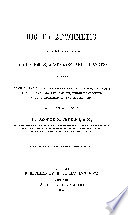 | George Roberts Perkins - 1849 - 344 páginas
...first term, the last term, and the number of terms, to find the common difference, we have this RULE, Divide the difference of the extremes by the number of terms, less one. EXAMPLES. 1. The first term of an arithmetical progression is 5, the last term is 176, and the... | |
 | Roswell Chamberlain Smith - 1850 - 314 páginas
...difference. Thus, 28 — 3= 25 ; then, 25 •*- 5= 5 years, the common difference. A. 5 years. 1 1 . Hence, to find the common difference, — Divide the...the number of terms, less 1, and the quotient will oe the common difference. 12. If the extremes be 3 and 23, and the number of terms 11, what is the... | |
 | Charles Guilford Burnham - 1850 - 350 páginas
...When the extremes and number of terms are given, to find the common difference, we have this RULE. Divide the difference of the extremes by the number...1, and the quotient will be the common difference. 7. If the first term of a series be 3, the last term 276, and the number of terms 40, what is the common... | |
 | George Roberts Perkins - 1850 - 356 páginas
...first term, the last term, and the number of terms, to find the common difference, we have this RULE. Divide the difference of the extremes by the number of terms, less one. EXAMPLES. 1 . The first term of an arithmetical progression is 5, the last term is 176, and the... | |
 | Benjamin Greenleaf - 1850 - 368 páginas
...differences, the quotient will be the common difference. Thus 16 -5- 8 = 2 is the common difference. RULE. — Divide the difference of the extremes by the number of terms less one, and the quotient is the common difference. 1. The extremes are 3 and 45, and the number of terms... | |
 | 1851 - 260 páginas
...progression, the first being $12, and the last, or fifty-second, payment $1236 ? Ans. 32448. NOTE &. —To find the common difference, divide the difference of the extremes by the number of terms, less one. EXAMPLES. 1 The ages of 8 boys form an arithmetical series-— the youngest is 4 years old and... | |
 | John Bonnycastle - 1851 - 314 páginas
...of terms, being given, to find the common difference. RULE.1)Divide the difference of the extremos by the number of terms less 1, and the quotient will be the common difference required. * If ii = the first term, l — \ast term, n = number of terms, rf=common difference, and... | |
 | Daniel Leach - 1851 - 280 páginas
...312. To find the common difference when the two extremes and the number of terms are. known,-— RULE. Divide the difference of the extremes by the number of \ terms , less one , and the quotient will be the common difference. This rule may be represented by the formula,... | |
 | Benjamin Greenleaf - 1851 - 332 páginas
...be the common difference. Thus, 27 -fr- 9 = 3, the common difference. Hence the following RULE. — Divide the difference of the extremes by the number of terms less one, and the quotient is the common difference. • EXAMPLES FOR PRACTICE. 1. The extremes of a series... | |
 | Daniel Leach - 1853 - 622 páginas
...312. To find the common difference when the two extvsmes and the number of terms are known, — RULE. Divide the difference of the extremes by the number of terms, less one, and the quotient will be the common difference. This rule may be represented by the formula, thus... | |
| |